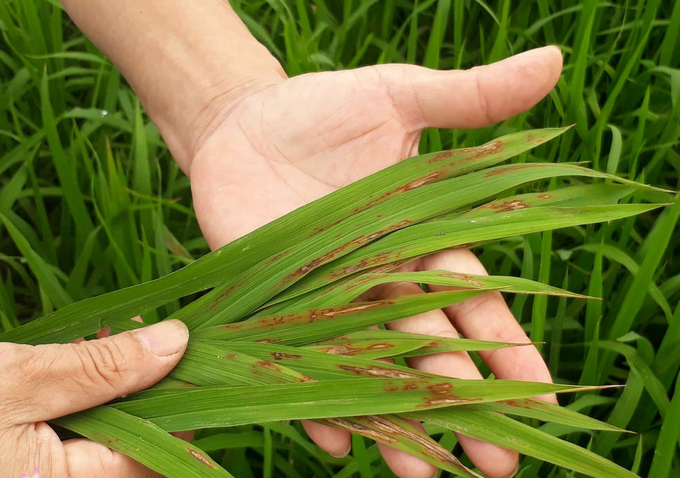According to the Nam Dinh Plantation and Plant Protection Agency, the weather in recent days has been affected by cold air, persistent drizzle, cloudy weather and high humidity, which have favored the occurrence of blast diseases. At present, leaf smut disease has occurred with a high prevalence of 5-7% in infected varieties (BC15, Taiwanese glutinous rice, velvety glutinous rice, Dai Thong 8…) in Nghia Loi, Nghia Binh (Nghia Hung); Giao Nhan, Giao Tien (Giao Thuy)… The disease will continue to spread in the near future and cause great damage to infected varieties.

In spring rice in Nam Dinh province, leaf smut disease has occurred with a high prevalence of 5-7% in infected varieties. Picture: MH.
Scattered small adult leaf moths also appeared, with 1-2 heads/m2, locally 5-7 juveniles/m2. The density of eggs and young worms 1 year old in one place is 20 – 40 individuals + fruits/m2, locally 100 – 150 insects + fruits/m2 in Giao Hai, Giao Tien (Giao Thuy); Tho Nghiep (Xuan Truong); Nghia Tan, Nghia Loi (Nghia Hung). The depth density is higher than in the same period last year. The young caterpillars bloom from April 4 to 7, causing local damage to early good rice along the province’s southern village.
White-backed leafhoppers have a low density, 50-100 insects/m2 in high places. The plague soon appeared in good paddy fields and will spread rapidly in the near future. In addition, the entire province has infected 224 ha with weed rice, concentrated in Nam Truc, Nghia Hung and Xuan Truong districts. Rats cause scattered damage, which is 3-5% high (the level of damage is higher than in the same period last year).
Leaf moths and peanut worms have an average density of 3 – 5 individuals/m2 on cash crops, with 10-20 individuals/m2 being high. Fall caterpillars cause damage to corn where the height is 2 – 5 heads/m2.
In light of the above situation, Nam Dinh Plantation and Crop Protection Sub-department proposed, District Agriculture and Rural Development Department; City Office of Economic Affairs; county and city agricultural service centers; Township/city agricultural committees across the province strengthen information, propaganda, investigation, detection and identification of areas with high density and high disease rates, to organize timely prevention according to the principle of prevention and control. “4 is correct”.
For powdery mildew, identify and remove good rice areas if the disease is early on.
For 1st generation leaf moths, concentrated spraying from April 5th to 8th for good early rice fields and village edges with a density of ≥ 20 insects/m2. Note that the small leafroller is locally widespread, the damage area is narrow, so it should only be sprayed unless the caterpillar shows the age of 2, 3; Avoid large-scale spraying that creates waste and pollution.

According to the Nam Dinh Plantation and Plant Protection Ministry, there is a risk that many pests and diseases will spread in the coming period. Picture: MH.
For fall worm, spray on corn unless density is ≥ 4 insects/m2, worm age 1 – 3. For leaf rollers and groundworm, spray on areas with density ≥ 10.
In addition, the increased investigation and detection of weed rice (ghost rice) is to remove by hand, this is a very effective task to destroy the source of the spread. At the same time, actively kill rats with measures, focusing on manual measures such as digging and trapping in combination with traps. In no case do not use electricity and measures dangerous to humans and pets to kill rats.
In addition, strengthening state management of plant protection products in counties and cities; Directing agents and distributors of pesticides to supply and instructing farmers on the use of the medicines in accordance with the guidance of the Department of Crops and Plant Protection.
In case of leaf scorch disease, stop applying nitrogen fertilizers, spray foliar fertilizers or growth promoters for infested areas. Use certain medicines to prevent the early onset of diseases, especially infected varieties such as BC15, Sticky Rice, Khang Dan 18, TBR225, Q5, QR1, Thien uu 8, Dai Thong 8, Phuc Thai 168… Should not be used a drug that contains only one active ingredient, isoprothiolane, to spray against blast disease.

